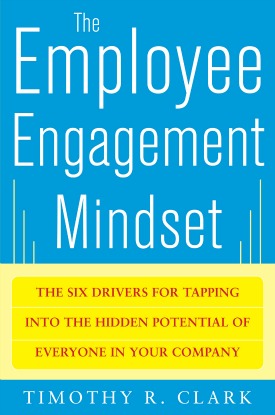
As an employee, you have three choices: Accept what you've been given, change what you've been given, or leave what you've been given. We want to focus on the second option. If you feel underused and undervalued, you can do something about it.
You may be tempted to hold the organization accountable for your engagement. If you still don't buy the argument that you're in charge of your own engagement, ask yourself: have you ever had true passion for something in life?
Most likely you can answer yes. So where did that passion come from? You get the point. Nobody can give you passion. Nobody can instill in you deep and rich and vibrant engagement. You have to do it. You should do it.
Engagement drives performance, both personally and organizationally. Torrents of data and reams of analysis have proven a direct relationship between the two. Engagement is the passion you have for what you're doing and the affection you have for the organization and its people. It's the comprehensive expression of your motivation and desire to contribute. Of course engagement levels vary. That's the problem. Some people are on fire. Others are frozen solid. Highly engaged people demonstrate focus, energy, and commitment. Disengaged people languish in complacency, indifference, and halfhearted effort. They think, feel, and act differently from truly engaged human beings. But that's not all. Engaged human beings deliver different results--to themselves and to their organizations.
Individuals who dive in and participate fully earn greater rewards and experience deeper personal and professional fulfillment. Show us a disengaged person, and we will show you lackluster performance, limited personal growth, and diminished rewards. Show us an engaged person, and it's just the opposite--high performance, accelerated personal growth, and inevitable success.
Two primary types of factors drive engagement: extrinsic factors and intrinsic factors. An extrinsic factor is something that comes from the out-side--meaning outside of you. It's something in the environment, something in the conditions or circumstances that surround you that influences you to become more engaged. For example, you may have a great boss, a nice office, or a new computer; the organization may be performing well; or perhaps you've been given a lot of training to do your job and a generous budget to accom- plish your priorities. These are all extrinsic factors--things that come from outside. Extrinsic factors are important, and they do have an impact on engagement levels. They create engagement from the outside in.
Intrinsic factors, on the other hand, come from the inside. They are inherent and are not dependent on outside conditions or circumstances. They are based on what you do. They're based on human action rather than environmental conditions. We've all experienced the power of an intrinsic factor. Just think about the times at work when you felt high motivation or a sense of deep satisfaction. Perhaps you learned something new. Maybe you really delivered on a project. Maybe you overcame a challenge. Maybe you helped someone who needed your help. Maybe you really love the kind of work you're doing. When you notice that your attention and motivation are increasing as you are doing something, that's an indication that something is going on inside, that intrinsic factors are at work and your engagement level is rising. When you act based on intrinsic factors, you don't do it for material or social rewards, you do it for invisible emotional, intellectual, and moral rewards. When you're engaged, it shows. It shows in your concentration, your effort, and your emotion. You can't hide it. Intrinsic factors create engagement from the inside out.
There are six drivers for engagement:
1) Connect: This driver includes developing great relationships and connecting socially. There's an intellectual dimension of connecting, which means that you connect to the work, people, and place on an intellectual level, and you find it stimulating. There's an environmental/cultural dimension of connecting, which means that you connect to the organization through its culture, its geography, and its environment. And there is an inspirational dimension of con- necting, which means that you connect to the organization based on its cause, mission, vision, values, or goals. On this dimension, you connect to what the organization represents and where it's going. To unlock this aspect, you have to discover which of these dimensions help drive your engagement and which one is your primary anchor.
2) Shape: Although you may not have complete control over your work and your work life, you do have more infl uence than you may realize. Shaping is the process of customizing, personalizing, and tailoring your professional experience based on your preferences while pursuing the organization's goals and acknowledging real constraints.
3) Learn: Think back on a time when you felt the thrill of learning. It was really stimulating, wasn't it? When people successfully learn and apply new knowledge and skills, it fuels their engagement.
 4) Stretch: Stretching means leaving your comfort zone, passing through your discomfort zone, and pushing on to your outer limits. Stretching increases your capacity to perform. It creates both discomfort and exhilaration. Whenever you stretch and go to your outer limits, you increase capacity and drive engagement to a high level.
4) Stretch: Stretching means leaving your comfort zone, passing through your discomfort zone, and pushing on to your outer limits. Stretching increases your capacity to perform. It creates both discomfort and exhilaration. Whenever you stretch and go to your outer limits, you increase capacity and drive engagement to a high level.
5) Achieve: Achieving replenishes energy, boosts confidence, deepens fulfillment, and elevates engagement. When you achieve, it becomes a self-reinforcing cycle that allows you to rely less on outside rewards.
6) Contribute: Human beings want to make a difference. It's an innate need, and we find that when an individual is contributing to another person, a group, or the greater good, he or she reaches the highest level of engagement. Contributing is the driver that brings the other fi ve together and gives them a higher level of expression and purpose.
There's no justification for an employee to wait expectantly for the organization to furnish engagement, as if it's something somebody can give you. The key to sustainable high engagement is taking primary responsibility for it. Now is the time to own your own engagement.
Excerpted from Timothy Clark's The Employee Engagement Mindset, ©2012, McGraw-Hill Professional; reprinted with permission of the publisher.
[Image: Flickr user James Whitesmith]